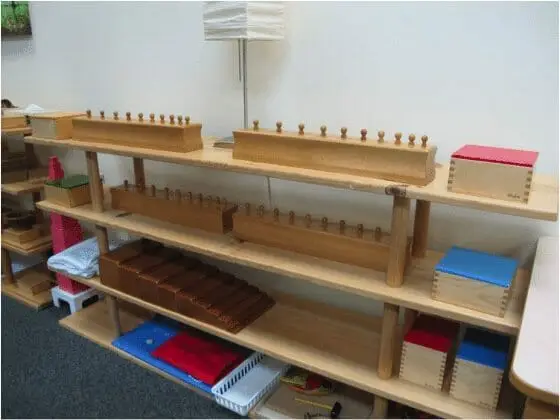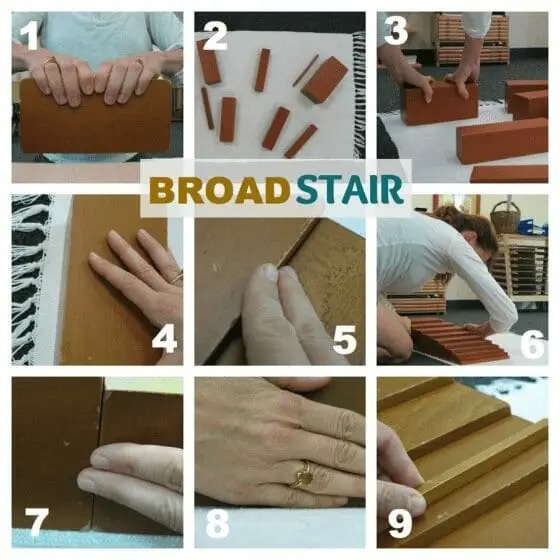I earn commissions from my affiliated links. Please see my disclosure policy for more details.
In Montessori classrooms, where hands-on learning takes the lead, every piece of material plays a vital role. One such material that holds immense educational value is the Brown Stairs. These simple, wooden blocks may seem basic at first glance, but they are anything but.
Designed to develop a child's understanding of size and dimension, the Brown Stairs offer a comprehensive tactile experience that engages multiple senses. As children manipulate these blocks and arrange them in varying sequences, they begin to grasp the concept of dimensionality, preparing them for more complex mathematical and spatial reasoning tasks.
Beyond the mathematical benefits, the Brown Stairs also promote concentration, hand-eye coordination, fine motor skills, and perseverance. By engaging with this material, children develop their cognitive, sensorial, and physical abilities, all while cultivating independence and a love for learning.
In this post, we will delve deeper into the educational value of Brown Stairs in Montessori classrooms, exploring how this simple material lays the foundation for a well-rounded education.
Broad Stairs in Montessori
The Montessori Brown Stair is work included within the Sensorial sequence. Specifically, it's located within the visual sense of the sequence. During these works, children learn to discriminate between the differences between various objects visually.

In Montessori education, the use of broad stairs has proven to be a powerful tool in fostering independence and spatial awareness in young learners. These unique educational structures offer a variety of benefits that can greatly enhance a child's development.
What is the Montessori Brown Stair?
The work is made up of 10 brown prisms of the same length (20 cm) and different height, and it's sometimes referred to as the Broad Stair work. The prisms vary from 10cm x 10cm x 20cm to 1cm x 1cm x 20cm. The Brown Stair is often combined with the Pink Tower for visual sensorial extension activities.

Developing Spatial Awareness through Broad Stairs
Independence is a fundamental aspect of Montessori education. By providing children with the opportunity to freely navigate the broad stairs, they are encouraged to make choices and decisions on their own. This fosters a sense of autonomy and self-confidence, which are crucial for their overall development.
Moreover, as children navigate the stairs independently, they learn to overcome challenges and solve problems on their own. They develop critical thinking skills and gain a better understanding of cause and effect. This sense of independence and problem-solving ability will serve them well in all aspects of their lives.
Benefits of Broad Stairs in Promoting Cognitive Development
One of the key benefits of broad stairs in Montessori education is the development of spatial awareness. As children navigate the uneven surfaces and varying heights of the stairs, they are challenged to understand concepts such as depth, distance, and perspective.
Through this hands-on experience, children develop a better understanding of their own bodies in relation to the surrounding environment. They learn to judge distances accurately and navigate their surroundings with confidence.
This spatial awareness is a crucial skill that will benefit them in various areas of their lives, such as sports, art, and everyday tasks.
How Broad Stairs Enhance Fine Motor Skills
The use of broad stairs in Montessori education has been found to have a positive impact on cognitive development. As children explore the stairs and make decisions about their movements, they engage their problem-solving and decision-making skills. This fosters cognitive growth and a deeper understanding of cause and effect.
Additionally, the wide and spacious design of the stairs provides children with ample opportunities for creative thinking and imaginative play. They can use the stairs as a stage for storytelling, a platform for building structures, or a space for engaging in pretend play. This creative exploration further enhances their cognitive abilities and encourages them to think outside the box.
The Montessori Brown Stair Lesson
You will need a work mat to complete this work.
Using both hands, grasp the broadest prism around the middle. Say, “Heavy.”
Carry the prisms to the mat, and position them randomly with the broadest close to the narrowest for contrast.
Select the broadest prism, and then grasp with both hands. Lift it carefully to the lower left corner of the rug. Keep the prism's long edge aligned with the left edge of the rug.

Run your index and third fingers along the space between the previously and newly placed prisms.
Take the time to look at the constructed stair with the child. Place your hands on either end of the broadest prism and slide them slowly back along the stair until you reach the narrowest prism.
Check the alignment of the edges. The little finger of each hand should touch the rug.
Walk the narrowest prism from left to right down the stairs, and observe, “Broadest. Narrowest.” Offer the child a turn. Once finished, return the prisms to the shelf, beginning with the broadest one.
There are many really great designs to do with the Pink Tower as extensions.
How do you incorporate the Montessori Brown Stair into your home school or classroom?Resources for the Brown Stair Lesson
The Lasting Impact of Broad Stairs in Montessori Education
Montessori educators have witnessed the positive impact of broad stairs on children's development. Many have shared success stories and testimonials highlighting the benefits of incorporating broad stairs into their classrooms.
One educator noted that the broad stairs allowed her students to develop a sense of independence and self-confidence. They took pride in navigating the stairs on their own and were motivated to explore the different heights and depths.
Another educator shared how the broad stairs enhanced her students' spatial awareness. By engaging with the stairs, the children developed a better understanding of their bodies in relation to the surrounding space. This newfound spatial awareness translated into improved performance in activities that required coordination and spatial reasoning.
